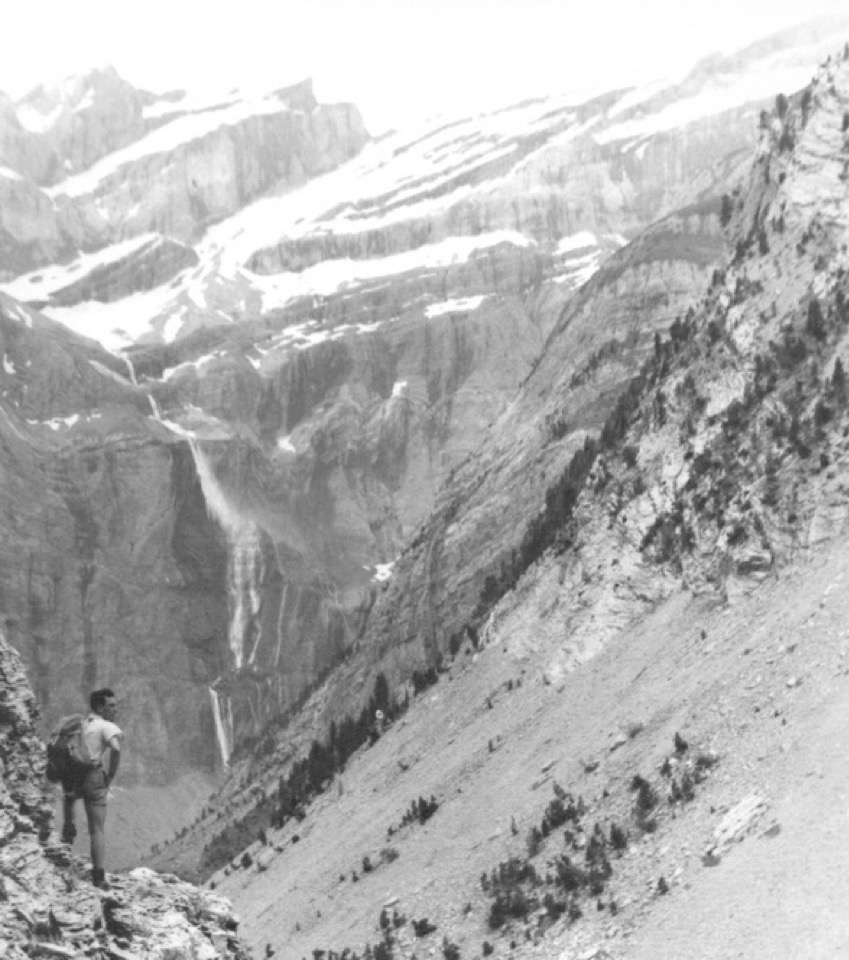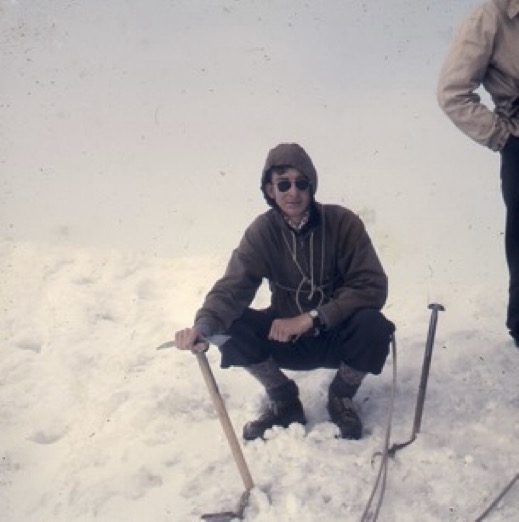1955 saw my last full season of racing with the Northwood Wheelers and I repeated my 100 mile club championship win of 1954. I also represented London University in the British Universities Cycling Union’s massed start (road race) held that year in Cambridge, although that did not come to much because I was involved in a crash a few miles after the start and half the field retired! I carried on cycling for the next two years, but gradually did less and less. There were three reasons for this decline. One was the increased work load leading up to finals in 1956; the second was a fleeting romance which ended in some heartache when she went off to University; and the third was the acquisition of new interests in mountain walking, rock and alpine climbing.
My interest in mountain walking began in 1955 on a King’s College expedition to the Cairngorms, where we camped in a deserted croft called Lynaberack some way up Glen Tromie, near Kingussie in the Spey Valley. My closest friend at King’s, John Burdin (we were later to become each other’s ‘best men’), already had some experience of walking and climbing, and we took the opportunity whilst on the expedition to explore the high peaks of the Cairngorms. We carried heavy camping gear through Glen Feshie and up to the top of Cairn Toul and Braeriach where we camped one night at the Pools of Dee, at over 4,000 feet. We then crossed the Lairig Ghru to climb Ben Macdui and Cairn Gorm to camp at the Shelter Stone at Loch Avon before returning to Lynaberack via the Rothiemurchus Forest, Aviemore and a short train ride to Kingussie. After the expedition, when the others had returned to London, I went on a 10-day bicycle tour of the western Highlands. This took me through Inverness, over to Ullapool and down through Skye, Glen Coe and back to Glasgow for the night train to London. The weather in the summer of 1955 was superb, throughout the expedition and then on the bicycle tour until I reached Skye. Then the heavens broke and it was very wet all the way to Glasgow. Details of this bike tour may be found on the web site.
One of the other expedition members that summer was Mike Salmon, a medical student at Middlesex Hospital Medical School who came on the expedition to study leaf hoppers (Cicadellidae). He was also, like me, a life-long butterfly enthusiast and (later, in 2000) the author of an excellent book The Aurelian Legacy). Mike and I, together with another expedition member Robin Joseph considered ourselves dapper young men-about-town. Even on a meagre student grant I bought a bespoke suit from Connock and Lockie’s of New Oxford Street, had shirts made for me and purchased an umbrella with a gold ferrule from James Smith’s.
At about the same time, my old cycling friend, Brian Huggins, came out of the RAF having completed his National Service, and we considered that what was lacking from our lives were girls! So we enrolled in local ballroom dancing classes. The enthusiastic lady who ran these classes said at the outset that she had never failed to teach people to dance. But six weeks later she admitted defeat, saying that Brian and I were tone deaf and lacking co-ordination. I never did learn to dance properly. We also joined the Pinner Young Conservatives having heard that they had the best-looking girls. We never actually met any, but I soon found myself on the committee. As committee member I even attended a YC convention held in Southend, and in 1958 acted as a courier for a group of YCs travelling to Spain. We travelled by coach from London to Lympne in Kent, then flew (for me the first time in an aeroplane) to Perpignan, then coach again across the Spanish border to San Filieu on the Costa Brava, at that time still completely unspoilt by mass tourism. This was still the time of the Franco regime and the Spanish authorities took away our passports at the border. We then had to report to the police station in San Filieu some days later to retrieve them.
In the summer of 1956 the final examinations for Zoology Honours arrived. Although I expected to do well and was predicted by my peers to get a first, I became rather nervous of the high expectations heaped upon me. This became even worse after the examinations were completed, and I remember sleepless nights walking around the streets close to home. Nevertheless, much to my relief, I did get the predicted first: I had got into a frame of mind where a second-class degree would have been regarded as a failure!
When the exams were finally over John Burdin and I went to the Pyrenees. This trip started out in our imaginations as a bona fide expedition to study butterfly migration across the border from France to Spain. After the strain of the exams we rather liked the idea of just lying on our backs on a warm mountainside idly counting butterflies as they passed overhead! However, we had to travel to the Pyrenees in mid-summer since we both had commitments later in the year when migration actually occurred. So the ‘expedition’ turned into a mountain walking holiday. We caught the Golden Arrow to Paris, and then crossed that city to the Gare d’Austerlitz to catch the night train south to Toulouse. It was the first time abroad for both of us, and one of my abiding memories of arriving in Toulouse was going into the station café and receiving the most delicious coffee in a ‘bowl’ without any handles. We then travelled on using a mixture of hitch-hikes, local trains and buses to our final destination, Gavarnie, in the high Pyrenees. We camped within the cirque, on one occasion actually above a violent thunderstorm that crackled around the valley below us. We climbed up to the Brèche de Roland on the Spanish border which we crossed without visas (it was the time of the Franco regime) fearing that we might be arrested and slung into gaol. After several days in this area we hitched a lift in an ancient Panhard to Bagnères de Luchon, where we stayed for another week or so. On this journey we crossed the cols made famous in the Tour de France: the Col du Tourmalet, the Col d’Aspin, and the Col de Peyresourde, still carrying the names of the famous riders painted on the surface of the road. Regrettably, we missed the Tour by just a week or so. For the record it was won in 1956 by a relatively unknown rider called Roger Walkowiak, a Frenchman of Polish extraction. It was to be nearly thirty years before I was able to actually see that race. After three weeks in the Pyrenees we returned to England. On arrival in Dover the customs officer demanded to know what I had got in my rucksack, suspecting drugs or something! When I answered “Just a load of dirty old clothes!” he made me turn them all out. In September, John went on to teacher training college, and I started to work for a higher degree.

John Burdin in the high Pyrenees, above Gavarnie
After the trip to the Pyrenees I became quite keen on the mountains and joined the London University Mountaineering Club. For a few months I went with them on climbing jaunts, as far away as North Wales, the Lake District and even the sea cliffs of Cornwall. A typical weekend trip would be: departure by coach on a Friday evening, driving all night to, say, Langdale Pikes, non-stop climbing all Saturday and Sunday with only a brief rest, then another all-night journey back to London in time for Monday morning. Although I never became very proficient at rock climbing, I found hanging on ‘jug-handle’ holds on exposed pitches quite exhilarating. In 1957 I met up with a group of climbers on Victoria station to travel to Austria on an Austrian Alpine Club course. Two alpine guides taught us the rudiments of snow and ice climbing, and we climbed the Grossglockner, the Gross Venediger and several other high peaks in the Austrian Tyrol.

On the Gross Venediger, 1957
Earlier, in 1956, I had started to look for a suitable Ph.D. programme. Initially I approached Don Arthur who worked on ticks, but he had too many students and would not take me on. At that time I became very interested in parasitic Hymenoptera and their possible use as agents of biological control. After discussions with John Cloudsley-Thomson and Don Arthur I was advised to contact Professor Douglas Bertram of the Entomology Department at the London School of Hygiene and Tropical Medicine, and I went up to Malet Street for an interview. Douglas Bertram was from the ‘school’ of medical entomologists trained at Glasgow University just before the war and was working on the transmission of nematode worms by blood-sucking mites. He had a strong Scottish accent (which I later got used to!) and I am not sure that the interview went all that well – at least, I didn’t really understand what was going on. Patrick Buxton, the head of the department of Entomology had died in 1955, but his influential book “The Natural History of Tsetse Flies” had just been published. Knowing my interest in parasitic Hymenoptera, Bertram opened the book to page 426 to show me a picture of a small Eulophid wasp Syntomosphyrum glossinae that had been used on several occasions in unsuccessful attempts to control tsetse flies in eastern and southern Africa. My remit was to investigate the biology of this small wasp - its survival in different environmental conditions, its behaviour, its host range and whether it could be used successfully as an agent of biological control.
